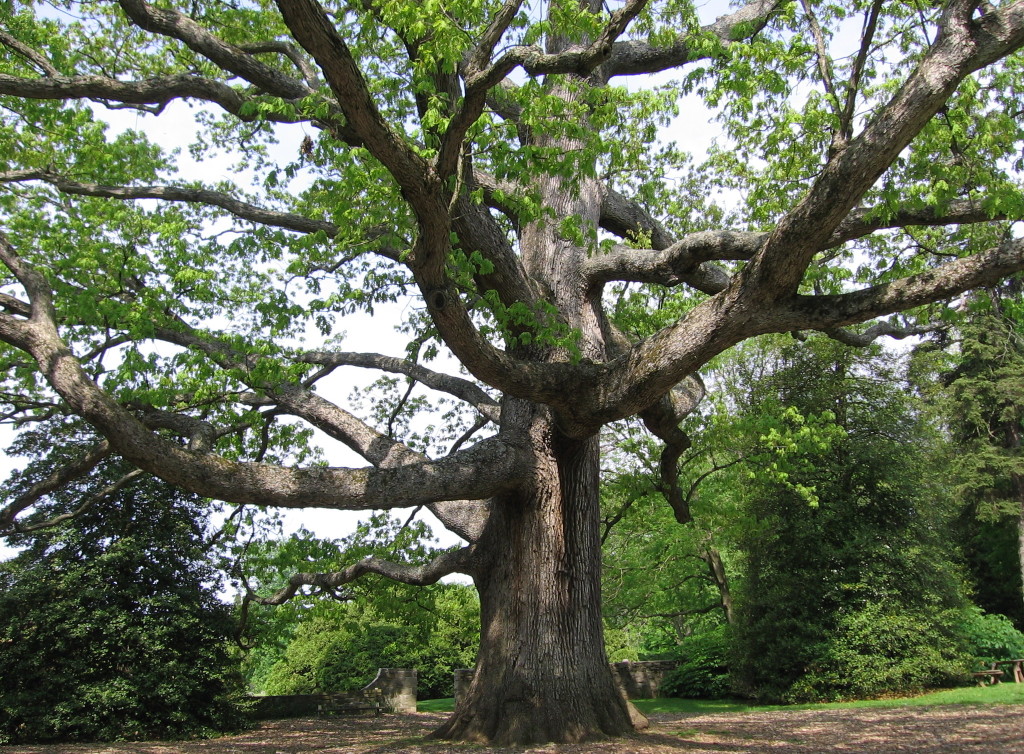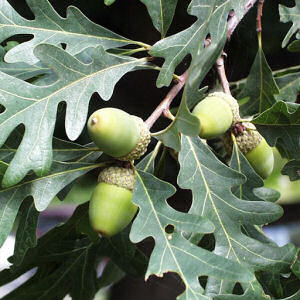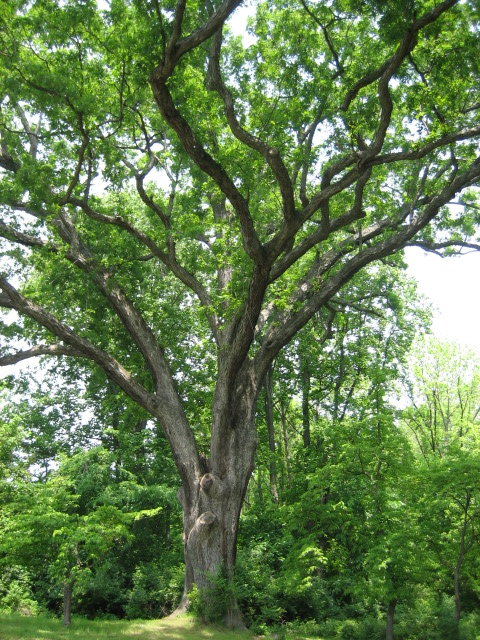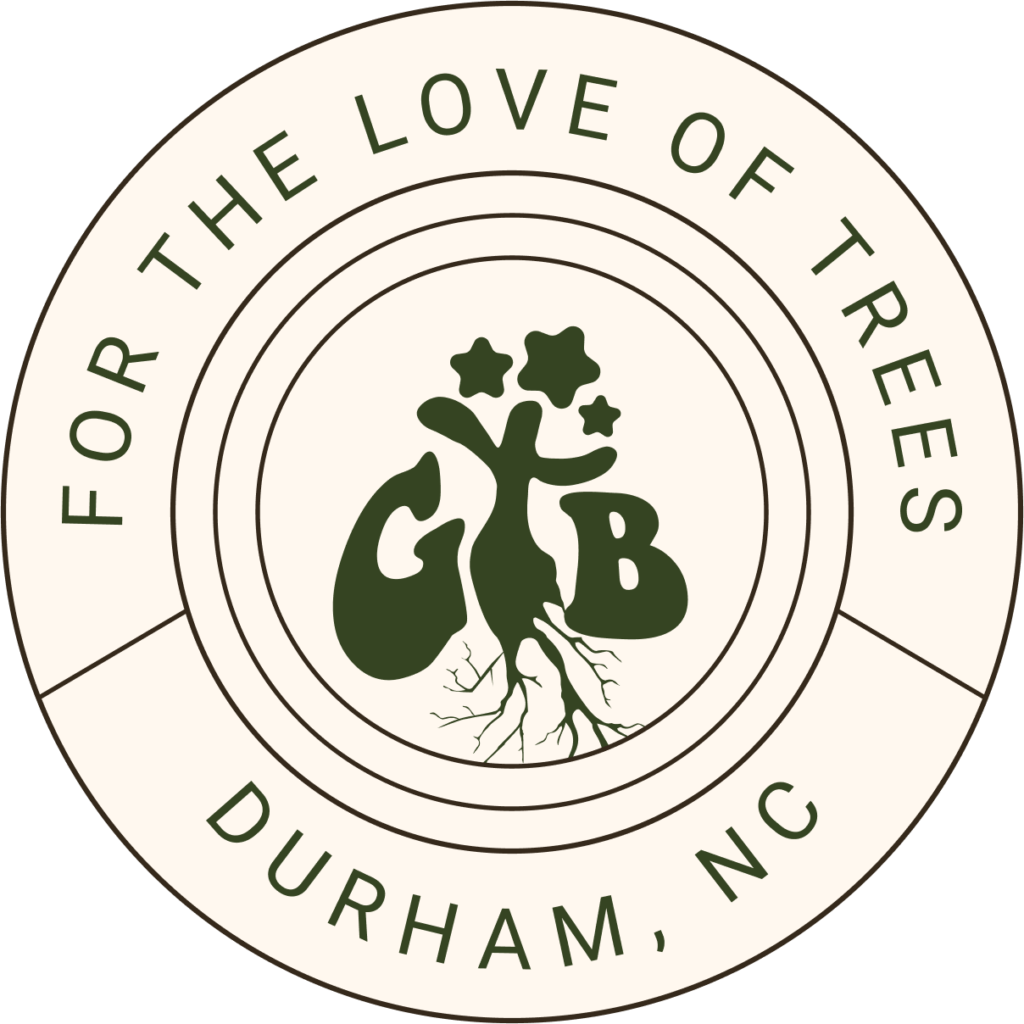Through the Grateful Trees and Bees Meet Your North Carolina Native Trees blog series, we’ll introduce you to the native trees we consider our friends.*

Quercus alba
Common Name: White Oak
Family: Fagaceae
Native Range: Eastern North America
Zone: 3b to 9
Height @ 15 years: 15-20 feet
Height @ 50 years: 40-50 feet
Height @ Maturity, 100+ years: 80-100 feet or more
Spread: 50-100 feet or more
Blooms: Late March to Late May, latitude dependent
Sun: Full sun to light shade
Water: Medium
Maintenance: Low, prune in dormant season
Tolerates: Clay Soil
Suggested Use: Shade Tree, Wildlife Habitat, Forestry
Why We Love White Oak
White oak (Quercus alba) is an old soul and familiar face in the forests of Eastern North America, growing as far South as northern Florida and eastern Texas, as far North as southern Quebec and as far West as eastern Minnesota. The oldest white oak on record, The Wye Oak, lived for 450 years in Wye Mills, Maryland before succumbing to a thunder storm in 2002. Its oldest surviving relative, The Linden Oak, has thrived in North Bethesda, Maryland for close to 300 years.

White Oak is a slow growing hardwood found primarily in forest uplands, though it can also grow along streams, lakes and ponds. When managing large tracts of forest land, the presence of white oak is a gift. When white oak is allowed to grow for 90 years or more, it rises above other species, self-propagating far and wide. The species is also a good companion for many other trees and is often found growing with other oaks, American beech, American sycamore, American basswood, black cherry, chestnut, Eastern red cedar, hickory, maple, sassafras, sweetgum and yellow poplar.
The tree is well adapted to North Carolina, preferring a heavy, damp, clay soil. White oak’s massive size comes not only from its upward growth, but also from its excurrent growth pattern in which a single trunk irregularly divides into widespread, often horizontal, stout branches.
White oak can be transplanted when young and makes a great shade tree on homesteads, in backyards, on playgrounds and in parks. It’s beneficial wildlife attributes make it a wonderful choice for establishing a wildlife habitat as well. White oak is not drought tolerant, but doesn’t express its decline until year two after a drought. If a white oak fails to leaf out in the Spring or drops its leaves in the Summer and it experienced a drought in the previous year, care must be taken to preserve the tree.
Despite the tree’s name, white oak rarely exhibits white bark, instead developing a light gray bark that fissures into long, broad, scaly plates that feel loose. The leaves are four to nine inches long, with five to nine finger-like lobes. Young leaves opalesce from silvery pink to light green and are initially covered with a downy tomentum. At maturity, leaves are a bright yellow-green, shiny or dull above and paler and smooth below. In late autumn the leaves turn a deep red and drop, or on young trees remain on the branches throughout the winter, making the tree a source of shelter and protection for wildlife year-round.

White oaks have male (greenish-yellow catkins that hang from twigs) and female flowers (small reddish spikes) and comes into sexual maturity at around 20 years, but isn’t a prolific acorn producer until it reaches 50 years of age. Because the acorns deteriorate quickly after ripening and are beloved food of many animals and insects, including the Eastern Gray Squirrel, Wild Turkey, Mallard, Eastern Chipmunk, Eastern Cottontail, White-footed Mouse, Raccoon, Blue Jay, Northern Bobwhite, Common Crow and Human, in years of a small crop, all can be lost. Yet white oak enjoys a symbiotic relationship with the wildlife that feeds on its acorns, relying on them to spread its seed. Viable acorns have no epigeal dormancy and germinate easily without treatment. In one growing season, from Fall to Spring, the oak root sprouts and the leaves and stem develop.
In addition to providing food and shelter to a large variety of wildlife, white oak is a boon for humans in many capacities. Perhaps most importantly to those of us who revere Dionysus, white oak is used to make barrels for aging wine because of its characteristic imparting of strong flavors as well as barrels for bourbon whiskey, which must be aged in charred new oak. White oak also provides lumber, furniture, paneling, flooring, railroad ties, mine timbers, caskets, shingles, baskets and some stellar firewood.
And yes, we can’t forget that humans too can consume its edible acorn fruit, which can be used to make an acorn flour for baking breads and pasta. This flour was a staple of Native Americans, containing protein, amino acids, carbohydrates and vitamins A and C. Check out Emergency Outdoors for a fabulous article on eating white oak acorns.
Here at Grateful Trees and Bees, our love for the noble white oak derives most from its wise spirit and the way that its longevity connects us to our ancestors. As we read the land in the North Carolina Piedmont, white oak is our guide to identifying the location of old homesteads. Our ancestors prized this tree, often cultivating one on each of the four corners of their home. White oak is a protector, a guardian of the four corners and a human ally. Long may white oak flourish.
*At Grateful Trees and Bees we hold a special gratitude for the many tree species native to North Carolina. Natives are species that have survived thousands of years of the climate conditions, pests and diseases found in our region. Their adaptations make them perfect for tree plantings and tree establishment projects because they are likely to thrive locally with minimal intervention. They provide the food and shelter that local wildlife has come to depend on; and they exhibit the beautiful foliage, flowers and bark you are familiar with seeing in your landscape.
© 2015 Grateful Trees & Bees

